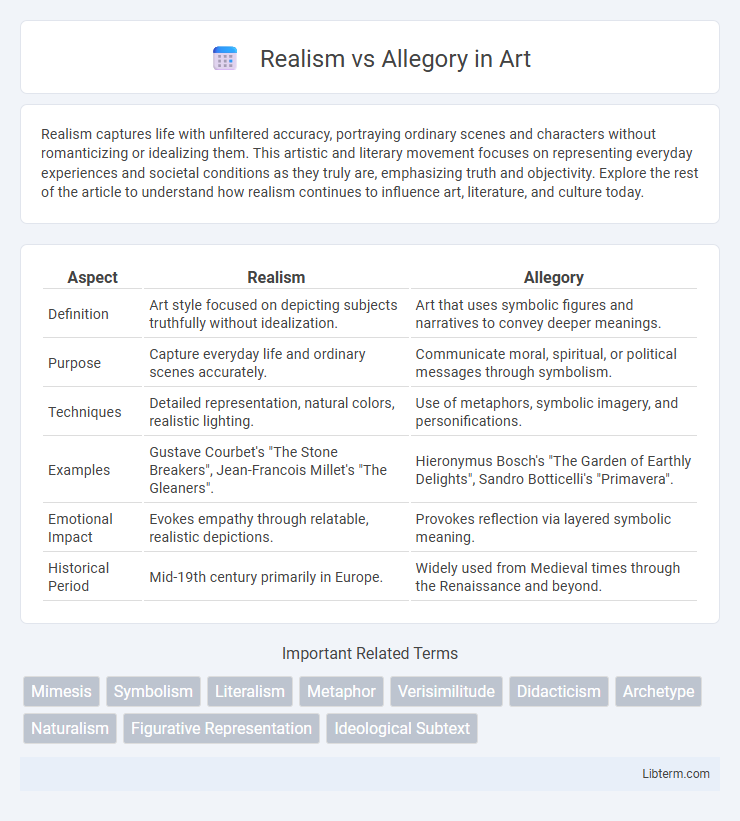Realism captures life with unfiltered accuracy, portraying ordinary scenes and characters without romanticizing or idealizing them. This artistic and literary movement focuses on representing everyday experiences and societal conditions as they truly are, emphasizing truth and objectivity. Explore the rest of the article to understand how realism continues to influence art, literature, and culture today.
Table of Comparison
| Aspect | Realism | Allegory |
|---|---|---|
| Definition | Art style focused on depicting subjects truthfully without idealization. | Art that uses symbolic figures and narratives to convey deeper meanings. |
| Purpose | Capture everyday life and ordinary scenes accurately. | Communicate moral, spiritual, or political messages through symbolism. |
| Techniques | Detailed representation, natural colors, realistic lighting. | Use of metaphors, symbolic imagery, and personifications. |
| Examples | Gustave Courbet's "The Stone Breakers", Jean-Francois Millet's "The Gleaners". | Hieronymus Bosch's "The Garden of Earthly Delights", Sandro Botticelli's "Primavera". |
| Emotional Impact | Evokes empathy through relatable, realistic depictions. | Provokes reflection via layered symbolic meaning. |
| Historical Period | Mid-19th century primarily in Europe. | Widely used from Medieval times through the Renaissance and beyond. |
Understanding Realism: Definition and Key Features
Realism is a literary and artistic movement emphasizing the accurate, detailed depiction of everyday life and ordinary people without idealization. Key features include a focus on plausible events, complex characters with psychological depth, and settings reflective of real social conditions. This approach contrasts with allegory by prioritizing literal truth and objective representation over symbolic or moral meanings.
Exploring Allegory: Definition and Core Characteristics
Allegory is a literary and artistic device that conveys abstract ideas and moral principles through symbolic figures, actions, and imagery, creating a layered narrative that extends beyond literal meaning. Core characteristics include the use of personification, metaphor, and extended symbolism to represent broader concepts such as good and evil, life and death, or societal critique. Unlike realism, which emphasizes accurate representation of everyday life, allegory seeks to impart deeper truths or lessons through imaginative storytelling and symbolic interpretation.
Historical Context: Realism and Allegory Through the Ages
Realism emerged in the mid-19th century as a response to Romanticism, emphasizing accurate, detailed depictions of everyday life and social conditions grounded in contemporary historical events. Allegory, with roots reaching back to ancient literature and medieval art, uses symbolic figures and narratives to convey deeper moral, spiritual, or political meanings shaped by the cultural and ideological contexts of their times. Throughout history, Realism provided a lens for direct social critique, while Allegory offered a layered, interpretative framework reflecting evolving historical and philosophical landscapes.
Major Works of Realism in Literature and Art
Major works of realism in literature include Gustave Flaubert's "Madame Bovary," which depicts everyday life with meticulous detail and psychological depth, and Leo Tolstoy's "Anna Karenina," emphasizing complex characters and social realities. In art, Gustave Courbet's paintings such as "The Stone Breakers" exemplify realism by portraying ordinary people engaged in labor without idealization. These works reject romanticized or symbolic interpretations, focusing instead on accurate, unembellished representations of contemporary life and society.
Notable Allegorical Works and Their Impact
Notable allegorical works such as George Orwell's *Animal Farm* and John Bunyan's *The Pilgrim's Progress* have profoundly shaped literary and cultural landscapes by embedding political and moral critiques within their narratives. These allegories employ symbolic characters and settings to address complex social issues, enabling deeper audience engagement through layered meanings. The enduring impact of these works lies in their ability to transcend literal interpretation, fostering critical reflection on power, morality, and human behavior across generations.
Techniques of Representation: Literal vs Symbolic
Realism employs detailed, literal techniques of representation to depict subjects as they appear in everyday life, emphasizing accurate visual and contextual fidelity. Allegory relies on symbolic methods, using metaphors, personifications, and abstract imagery to convey deeper moral, political, or spiritual meanings beyond the literal narrative. This contrast highlights realism's commitment to objective observation, while allegory prioritizes layered interpretations through symbolic representation.
The Purpose: Conveying Truths in Realism and Allegory
Realism aims to depict life and society with accuracy, focusing on everyday experiences and concrete truths to provide a clear, objective representation of reality. Allegory, by contrast, uses symbolic figures and narratives to convey deeper moral, spiritual, or political truths, often transcending specific historical contexts. Both methods serve the purpose of communicating truths, but realism relies on direct observation while allegory emphasizes metaphorical meaning.
Audience Interpretation: Directness vs Hidden Meanings
Realism presents narratives with clear, straightforward depictions, enabling audiences to grasp the story and characters with minimal ambiguity, fostering immediate emotional connections. Allegory relies on symbolic elements and layered meanings, inviting audiences to decode hidden messages and interpret underlying themes beyond the surface narrative. This contrast shapes how viewers engage with the work, either through direct experience or analytical reflection.
Strengths and Limitations: Realism and Allegory Compared
Realism excels in depicting everyday life with detailed accuracy, offering clear and relatable narratives that emphasize authenticity and social truths. Allegory thrives on symbolic meaning, enabling complex ideas and moral lessons to be conveyed through metaphorical representation, which invites deeper interpretation but can sometimes obscure clarity. While Realism's strength lies in directness and factual representation, its limitation is a narrower thematic scope; Allegory's strength is its rich, layered meanings, but it may sacrifice immediacy and accessibility for symbolic complexity.
Modern Relevance: Realism and Allegory in Contemporary Culture
Realism in contemporary culture emphasizes authentic representation of everyday life, capturing social dynamics and personal struggles with factual accuracy. Allegory remains relevant as a powerful tool for conveying complex ideas and moral lessons through symbolic narratives, resonating in literature, film, and visual arts. The interplay between Realism and Allegory enriches modern storytelling by balancing factual detail with deeper thematic meaning, reflecting current social and political issues.
Realism Infographic

 libterm.com
libterm.com